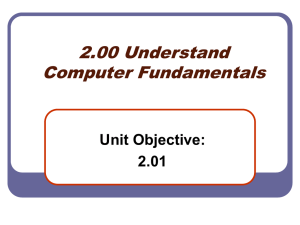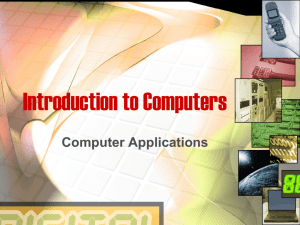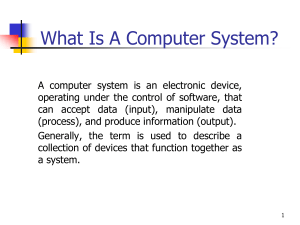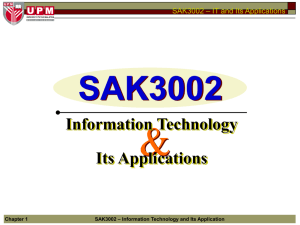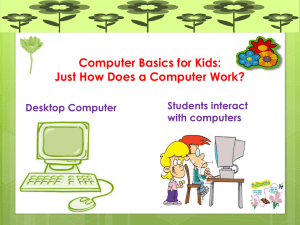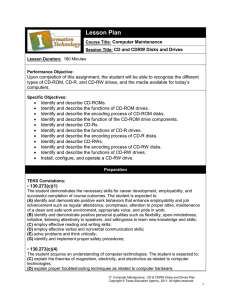News
advertisement
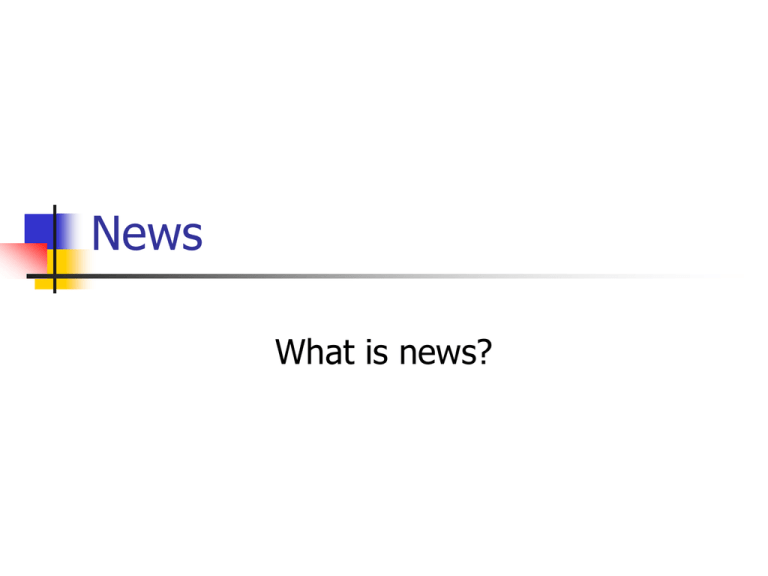
News What is news? News Value Criteria for news value? Criteria Timeliness Localness or proximity Prominence or importance Names Size Dollars Consequence and/or conflict Human interest Inverted Pyramid Lead with 5W – 1H Basics on Preparing News Copy Page 6-7 Writing a News Release: A Checklist Formats News release (2 page max) Feature Story Exclusive, special or general Tip sheets General To attract media Fact or briefing sheets Practice Exercise Small groups 3-4 Page 23 – Release A What kind of lead? AFS space (P: Drive) bit Short for binary digit, the smallest unit of information on a machine. The term was first used in 1946 by John Tukey, a leading statistician and adviser to five presidents. A single bit can hold only one of two values: 0 or 1. More meaningful information is obtained by combining consecutive bits into larger units. For example, a byte is composed of 8 consecutive bits. Computers are sometimes classified by the number of bits they can process at one time or by the number of bits they use to represent addresses. These two values are not always the same, which leads to confusion. For example, classifying a computer as a 32-bit machine might mean that its data registers are 32 bits wide or that it uses 32 bits to identify each address in memory. Whereas larger registers make a computer faster, using more bits for addresses enables a machine to support larger programs. Graphics are also often described by the number of bits used to represent each dot. A 1-bit image is monochrome; an 8-bit image supports 256 colors or grayscales; and a 24- or 32-bit graphic supports true color. Byte Abbreviation for binary term, a unit of storage capable of holding a single character. On almost all modern computers, a byte is equal to 8 bits. Large amounts of memory are indicated in terms of kilobytes (1,024 bytes), megabytes (1,048,576 bytes), and gigabytes (1,073,741,824 bytes). Hard Disk Drive The mechanism that reads and writes data on a hard disk. Hard disk drives (HDDs) for PCs generally have seek times of about 12 milliseconds or less. Many disk drives improve their performance through a technique called caching. There are several interface standards for passing data between a hard disk and a computer. The most common are IDE and SCSI. Floppy Drive A soft magnetic disk. It is called floppy because it flops if you wave it (at least, the 5¼-inch variety does). Unlike most hard disks, floppy disks (often called floppies or diskettes) are portable, because you can remove them from a disk drive. Disk drives for floppy disks are called floppy drives. Floppy disks are slower to access than hard disks and have less storage capacity, but they are much less expensive. And most importantly, they are portable. Floppies come in two basic sizes: 5¼-inch: The common size for PCs made before 1987. This type of floppy is generally capable of storing between 100K and 1.2MB (megabytes) of data. The most common sizes are 360K and 1.2MB. 3½-inch: Floppy is something of a misnomer for these disks, as they are encased in a rigid envelope. Despite their small size, microfloppies have a larger storage capacity than their cousins -- from 400K to 1.4MB of data. The most common sizes for PCs are 720K (double-density) and 1.44MB (high-density). Macintoshes support disks of 400K, 800K, and 1.2MB. Zip Drive A high-capacity floppy disk drive developed by Iomega Corporation. Zip disks are slightly larger than conventional floppy disks, and about twice as thick. They can hold 100 or 250 MB of data. Because they're relatively inexpensive and durable, they have become a popular media for backing up hard disks and for transporting large files. CD-ROM Drive Abbreviation of Compact Disc-Read-Only Memory. A type of optical disk capable of storing large amounts of data -- up to 1GB, although the most common size is 650MB (megabytes). A single CD-ROM has the storage capacity of 700 floppy disks, enough memory to store about 300,000 text pages. CD-ROMs are stamped by the vendor, and once stamped, they cannot be erased and filled with new data. To read a CD, you need a CD-ROM player. All CD-ROMs conform to a standard size and format, so you can load any type of CD-ROM into any CDROM player. In addition, CD-ROM players are capable of playing audio CDs, which share the same technology. CD-ROMs are particularly well-suited to information that requires large storage capacity. This includes color large software applications, graphics, sound, and especially video. CD-R Short for Compact Disk-Recordable drive, a type of disk drive that can create CD-ROMs and audio CDs. This allows users to "master" a CDROM or audio CD for publishing. Until recently, CD-R drives were quite expensive, but prices have dropped dramatically. A feature of many CD-R drives, called multisession recording, enables you to keep adding data to a CD-ROM over time. This is extremely important if you want to use the CD-R drive to create backup CD-ROMs. To create CD-ROMs and audio CDs, you'll need not only a CD-R drive, but also a CD-R software package. Often, it is the software package, not the drive itself, that determines how easy or difficult it is to create CD-ROMs. CD-R drives can also read CD-ROMs and play audio CDs. CD-RW Short for CD-ReWritable disk, a type of CD disk that enables you to write onto it in multiple sessions. One of the problems with CD-R disks is that you can only write to them once. With CD-RW drives and disks, you can treat the optical disk just like a floppy or hard disk, writing data onto it multiple times. The first CD-RW drives became available in mid-1997. They can read CD-ROMs and can write onto today's CD-R disks, but they cannot write on normal CD-ROMs. This means that disks created with a CD-RW drive can only be read by a CD-RW drive. However, a new standard called MultiRead, developed jointly by Philips Electronics and Hewlett-Packard, will enable CD-ROM players to read disks create by CD-RW drives. Many experts believe that CD-RW disks will be a popular storage medium until DVD devices become widely available. CD-RW, CD-R and CD-ROM Compatibility There are a number of compatibility issues associated with CD-RW. First and foremost is the fact that CD-RW media are not backwardcompatible with many regular CD-ROM drives. Due to the lower reflectivity of the CD-RW media, regular drives can have problems reading them. In essence, the CD-RW media just does not emulate the pits and lands of a regular pressed CD well enough to fool a standard reader. Another problem is that CD-RW media are recorded in a multi-session format. Single-session disks are written an entire disk at a time, which obviously isn't practical for a rewriteable medium. Many regular CDROM drives are multi-session compatible, but many are not. One of the great strengths of CD-R is the fact that once you create a disk, it can be read in basically any reasonably-modern PC that has a CD-ROM player. Since CD-RW media does not have this large advantage of universality, it is, in my opinion, relegated into "the pack" of competing removable mass storage formats, such as removable hard disks, high-capacity floppies, and magneto-optical drives. All of these provide removable, rewriteable storage at different price points, and all share the disadvantage of not being readily usable on PCs that don't have the right type of special drive.
